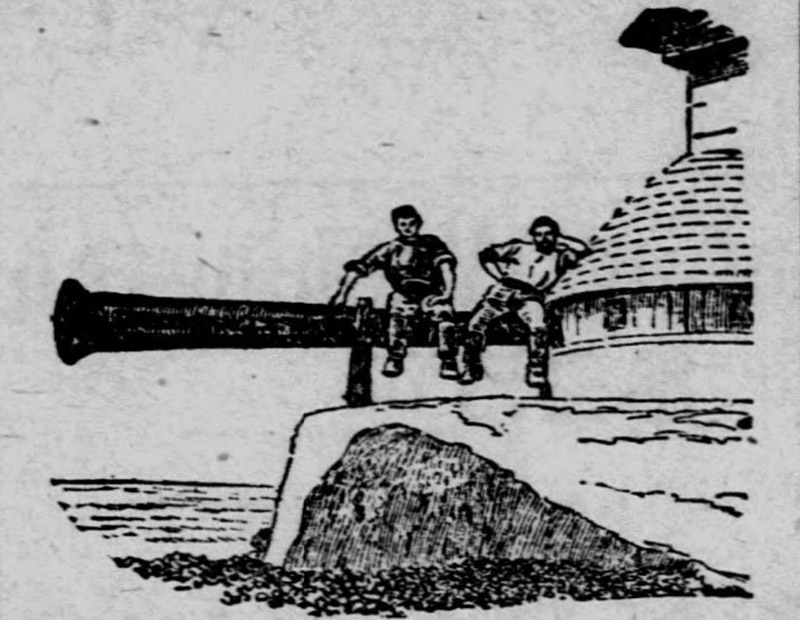The Newfoundland Quarterly.
Vol. XII.-N0. 1. JULY, 1912.
Newfoundland Name-Lore
By His Grace, Archbishop Howley.
On Sillers’ map (1671) the islands of St. Pierre, Miquelon and Langley are represented surrounded by a bank or shoal, and are named « Greene isles. »
On Thornton’s map (1689) we have the following: — [..], Langlou, Dunes (shown as an island) and Maquelan. All these islands are shown correctly in their places as they stand on our maps of today, except that at present the Dunes is but a strip of sand joining the islands of Miquelon and Langley. On the main land opposite these islands, and occupying the place held on modern maps by Dantzic Point, we have Gr. Dane and Pet. Dane (great and little Dane).
On Fitzhugh’s map (1693) we have as follows: — S. Pierre, I Verte, Langlois and Maquelon. all in their proper places. At the northern point of Langlois is shown a shoal or beach called Dunes. It is in the spot occupied by the Dunes at the present day, but it does not reach as far as Miquelon. It is attached by its southern end to the N. end of Langlois, an the opening or gut is shown at the northern end of this tongue a beach between it and Miquelon Island At the present day there no opening or gut, and this tongue of beach joins both islands. We find, however, by Cook’s maps that this gut or opening existed as late as 1784. On Fitzhugh’s map mentioned above (1693), besides the islands and dunes, at Miquelon we have, on the main land, on the site of Dansic, Gr. Dane and Pt. Dans. On Moll’s map (1735) we have the following islands: — I. St. Peter, Dunes: Maynelon (a mistake for Maquelon), and on the mainland G. Dans, and P. Dans (great and little Dins). On a map in the « British Pilot » date 1735, we have, in its proper place between Miquelon and Langlois, Dunes, while on the main land at Dantzic Point we have Grand done and Petit done. The name finally developed into Dantzu, though exactly when, I have been unable to find out. The earliest date at which I find it is on Cook’s map of 1784. I find it also in the « American Coast Pilot » of 1806. It is easy to trace the source and transition of the word. We have first the ordinary and frequently used word, DUNES. […]
The spit of sand at Miquelon still retains the name of the Dunes. In the course of time the name became transferred from the island to the mainland immediately opposite. This is a process of translocation which we find very frequently occuring all over the coast of Newfoundland Having by this transfer lost it, ong.na characteristic of a beach or anchorage-ground, it began also to lose its name. Hence we find the numberless variations such as Danie. Dane, Dans, Done. &c., &c. the two islands of Langley and Miquelon form part of the Archpelaeo of St Pierre and belong to the French Government. At the present […] of beach called the Dunes and form a sort of Geographical Siamese twins. […] quite recently there was a gut, and they were two separate islands.
LANGLADE. This I consider to be a French attempt at pronouncing the word England The St. Pierrais, (hat is the French-men of the island of S. Pierre, gave the name of England, in their [..] L’Anglade, to all Newfoundland, and somehow or other it became confined lo the large double island in their neighbourhood, in the mouth of Fortune Bay. […]Another explanation of LANGLADE may be the following. Ii is a French family name and we find that at the siege of Louisburg 1755 there was a Monsieur Mouet de Langlade, a Captain of a regiment of Artois, in the French Army. He was taken prisoner by the English. But as he was in the army and not in the navy, and […] not found his name in any way connected with Newfoundland, I cannot say if it has any connection with the name of the island of Langlade.
The third and largest island of the St. Pierre group is MIQUELON; the origin and meaning of this name is not known to me. It will be seen from what 1 have already written that it had many variants. The first time I […] it is on Mason’s or Vaughan’s map of 16[..]. It is there given with the English phonetic spelling MICKLON. On Fitzhugh’s map, 1693 it appears as « [..] ». On Thornton’s map, 1619 the same form. On [..] 1713. [..] On Cour Letter’s, 1720 we have it as [..] m. On Molls map, 1735 it appears as Maynelon. This is evidently a misprint. The same form appears on a map in the British Pilot dated 1755. On Cook’s maps, 1774, and from that time onwards to the present the name of Miquelon remains permanent.
